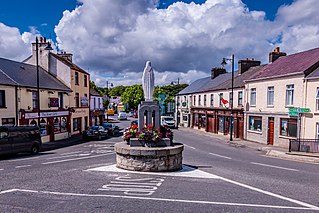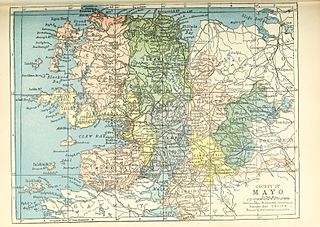
County Mayo is a county in Ireland. In the West of Ireland, in the province of Connacht, it is named after the village of Mayo, now generally known as Mayo Abbey. Mayo County Council is the local authority. The population was 137,231 at the 2022 census. The boundaries of the county, which was formed in 1585, reflect the Mac William Íochtar lordship at that time.

Killala is a village in County Mayo in Ireland, north of Ballina. The railway line from Dublin to Ballina once extended to Killala. To the west of Killala is the townland of Townsplots West, which contains a number of ancient forts. Historically associated with Saint Patrick, and the seat of an episcopal see for several centuries, evidence of Killala's ecclesiastical past include a 12th-century round tower and the 17th century Cathedral Church of St Patrick. As of the 2016 census of Ireland, the village had a population of 562. The village is in a civil parish of the same name.

Crossmolina is a town in the historical barony of Tyrawley in County Mayo, Ireland, as well as the name of the civil parish and Catholic parish in which the town is situated. The town sits on the River Deel near the northern shore of Lough Conn. Crossmolina is about 9 km (5.6 mi) west of Ballina on the N59 road. Surrounding the town, there are a number of agriculturally important townlands, including Enaghbeg, Rathmore, and Tooreen.
Bangor Erris is a town in Kiltane parish in Erris, County Mayo, Ireland with a population of over 300. It is on the banks of the Owenmore River and is a "gateway" to the Erris Peninsula linking Belmullet with Ballina and Westport. It is located at the foot of the "Bangor Trail" a 22-mile mountain pass across the Nephin Beg Mountain Range to Newport. Approximately 2 km away is Carrowmore Lake, Bangor is a centre for wild atlantic salmon and sea trout fishing. Bangor Erris is located in the Parish of Kiltane. Due west from Bangor are the towns of Belmullet, Geesala, Mulranny, Westport and Doolough.

Ballysadare, locally also Ballisodare, is a town in County Sligo, Ireland. It is about 7 km (4 mi) south of Sligo town. The town developed on an important crossing of the Owenmore River. Ballysadare is in a townland and civil parish of the same name.

Gweesalia or Geesala is a small Gaeltacht village situated on the Gweesalia peninsula in the Electoral Division of Rathhill, in the Civil Parish of Kilcommon, in the Barony of Erris in western County Mayo, Ireland.

Glenamoy is a village in the civil parish of Kilcommon, Erris in the northern part of County Mayo in Ireland. The R314 road passes through Glenamoy.

The Diocese of Killala is a Latin Church diocese of the Catholic Church in Connacht; the western province of Ireland. It is in the Metropolitan Province of Tuam and is subject to the Metropolitan Archdiocese of Tuam. As of 2024, the seat of the Diocese is “Sede Vacante” meaning there is no current permanent Bishop appointed for this Diocese

Kilmovee is a village and civil parish in County Mayo, Ireland. It is a mainly rural parish on the R325 road, midway between Kilkelly and Ballaghaderreen.

Ardagh is a civil parish and townland in County Mayo, located slightly to the southwest of Ballina.

Moycashel, previously the barony of Rossaughe, and before that, Delamares country, is a barony in south County Westmeath, in Ireland. It was formed by 1542. It is bordered by three other baronies: Clonlonan to the west, Rathconrath to the north, Moyashel and Magheradernon to the north-east and Fartullagh to the west. The largest population centre is Kilbeggan.

Deel Castle was built in the 16th century by the Bourkes and later renamed Castle Gore. It is located near the town of Crossmolina, County Mayo, in Ireland

Tirawley, archaically known as Tyrawley, is a barony extending southward from the north coast of County Mayo, Ireland. It was created during the shiring of County Mayo out of the Gaelic túath or territory of Tír Amhlaidh, from which it takes its name.
The civil parish of Kilcommon in Erris, northern County Mayo, Ireland has a total of 37 townlands: small geographic divisions of land in Ireland and Scotland's Outer Hebrides. Townlands originated in Gaelic Ireland, and predate the late-12th-century Anglo-Norman invasion. However, some townland names are derived from British plantations and Norman manors.

Ballina is a town in north County Mayo, Ireland. It lies at the mouth of the River Moy near Killala Bay, in the Moy valley and Parish of Kilmoremoy, with the Ox Mountains to the east and the Nephin Beg mountains to the west. The town occupies two baronies; Tirawley on the west bank of the Moy River, and Tireragh, a barony within County Sligo, on its east banks. At the 2022 census, the population of Ballina was 10,556.
Ardagh GAA is a Gaelic Athletic Association club located in County Mayo, Ireland. The club, which is based in Cloonkee in Ardagh, plays Gaelic football and is a member of the North division of Mayo GAA. As of 2024, the club was fielding teams in the Mayo Junior Football Championship.
Tír Amhlaidh was a túath in northwest Ireland. It is now represented by the barony of Tirawley, County Mayo. The name is derived from Amhalghaidh, son of Fíachra son of Eochaid Mugmedon of the Connachta group of early Gaelic dynasties.
Enaghbeg is a townland located in the Barony of Tirawley, in the County of Mayo. It is in the Electoral Division of Deel, in a civil parish of Crossmolina. Agriculture is the primary economic activity.

Cloghans is a townland in the parish of Kilbelfad and historical barony of Tirawley, County Mayo in Ireland. It is situated on the eastern shore of Lough Conn, at an average elevation of 14 metres above the sea level. The nearest townlands are Knockanillaun, Newtowngore, Gortogher and Gurteens, and the nearest towns are Crossmolina and Ballina. The Rathduff church is within the townland. Cloghans is approximately 1.04 square kilometres (0.4 sq mi) in area.

















